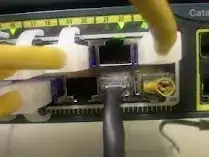We've a Cisco 2960e that services our VoIP phones and other things. I inherited it.
The question I have is the cut cables: there are about four network connectors that are cut about 1cm away from the end - making it nothing more than a physical connector. These connectors are paired with a working cable either on above or beneath.
I feel certain these connectors are some sort of flag; they can't be loop-backs as there is no cabling to do so (the connectors are cut and nothing else). There's no electrical connections: the only indicator the switch might realize is there is a physical presence in the jack - and I doubt that too.
The free ports are ominously quiet (of network traffic) as well: is this related? Are these connectors marking active ports?
UPDATE: I thought I was very clear; I don't know how I could have explained it any better. In any case, here's a picture:
